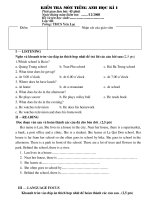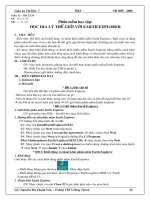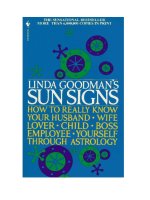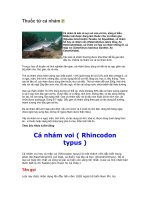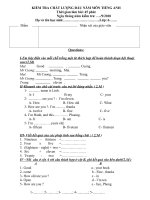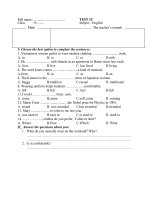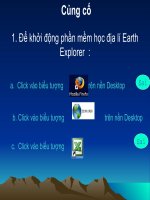- Trang chủ >>
- THPT Quốc Gia >>
- Hóa
Earth sun moon
Bạn đang xem bản rút gọn của tài liệu. Xem và tải ngay bản đầy đủ của tài liệu tại đây (4.67 MB, 10 trang )
Space and Technology
Genre
Nonfiction
Comprehension Skill
Main Idea and Details •
•
•
•
Text Features
Captions
Labels
Diagrams
Glossary
Science Content
Earth and Space
Scott Foresman Science 6.19
ISBN 0-328-14024-4
ì<(sk$m)=beace < +^-Ä-U-Ä-U
by Carol Levine
Vocabulary
What did you learn?
lunar eclipse
1. Why does the Sun look like the largest star in the sky?
orbit
2. Does the Moon giveby
off light?
WhyLevine
does the Moon seem to be lit?
Carol
revolve
rotate
solar eclipse
Illustrations: Title Page, 10 Bob Kayganich; 14 Peter Bollinger
Photographs: Every effort has been made to secure permission and provide appropriate credit for
photographic material. The publisher deeply regrets any omission and pledges to correct errors called to its
attention in subsequent editions. Unless otherwise acknowledged, all photographs are the property of Scott
Foresman, a division of Pearson Education. Photo locators denoted as follows: Top (T), Center (C), Bottom
(B), Left (L), Right (R), Background (Bkgd).
2 ©GSFC/NASA; 3 ©John Sanford/Photo Researchers, Inc.; 4 ©John Sanford/Photo Researchers, Inc.,
(BC) ©GRIN/NASA; 10 (CR) ©Jan Halaska/Photo Researchers, Inc.; 11 (T, BC, CR) ©Jan Halaska/Photo
Researchers, Inc.; 12 ©Roger Ressmeyer/Corbis
ISBN: 0-328-14024-4
Copyright © Pearson Education, Inc.
All Rights Reserved. Printed in the United States of America. This publication is
protected by Copyright and permission should be obtained from the publisher prior
to any prohibited reproduction, storage in a retrieval system, or transmission in any
form by any means, electronic, mechanical, photocopying, recording, or likewise. For
information regarding permissions, write to: Permissions Department, Scott Foresman,
1900 East Lake Avenue, Glenview, Illinois 60025.
2 3 4 5 6 7 8 9 10 V010 13 12 11 10 09 08 07 06 05
Earth, Sun, and Moon
3. What causes the Moon to appear to be different shapes during
a month?
4.
The tilt of Earth on its axis causes the
seasons. Write to explain how seasons change because of Earth’s
tilt. Use details from the book to support your answer.
5.
Main Idea and Details Reread page 7. Write a
sentence that gives the main idea of the page. Under that
sentence, list two supporting details.
What are the
characteristics
of Earth’s Sun
and Moon?
Earth’s Moon
The Moon has no light of its own. Sunlight reflects off the Moon’s
surface. This is what makes it appears lit. The Moon is like a giant
rock in space. It has almost no atmosphere.
The Moon revolves, or moves in a path, around Earth. The Moon
also spins on its axis, or rotates, as it revolves. The same side of the
Moon always faces Earth. This is because the time it takes the Moon
to revolve and the time it takes to rotate are the same.
Our Sun
Our Sun is a star. It only appears to
be larger than other stars because it
is much closer to Earth than the stars
we see at night. It is made of hot gases
called plasma. The Sun does not burn;
it glows similar to a light bulb.
A heavy core makes up the inner part
of the Sun. Its temperature is about
15 million degrees Celsius. Particles
react in the core and release large
amounts of energy. This provides light
and heat that living things on Earth
need to live. Without the Sun, Earth
would be cold and could not support
life.
The Sun has no solid surface. Swirling
layers of plasma surround the core.
Prominences are large loops of gases
that extend thousands of kilometers
from the Sun. Some stay in place for
weeks. Others explode into space.
Solar flares are temporary releases of
energy from the Sun’s surface. Energy
from these flares can reach Earth. This
energy causes auroras, which are light
displays usually seen near Earth’s poles.
2
3
Phases of the Moon
Learning About the Moon
The Moon appears to change shape each night of the month. But it
does not actually change. The different shapes are called the phases
of the Moon. We see these changes because of changes in the size of
the lighted part of the Moon we can see. Only the half of the Moon
that faces the Sun is lighted. The positions of the Moon, Earth, and
the Sun determine how the Moon will look from Earth at any given
time. A complete cycle of the Moon happens every 29.5 days.
The first visit to the Moon happened in 1959. An unmanned Soviet
spacecraft called Luna 2 landed on the Moon’s surface. In 1969, Apollo
11 carried astronauts Edwin “Buzz” Aldrin and Neil Armstrong,
the first humans to land on the Moon. There were five more Moon
landings. The last one was in 1972.
Information collected during the Moon landings has helped us
learn about the Moon, Earth, and the rest of the solar system. The
craters and other features of the Moon’s surface have been examined.
This helps scientists find out the ages of the Moon and of Earth.
Waxing
Crescent
First Quarter
As the Moon begins to wax, or grow
larger, a crescent of light begins to
show on the side. Each night you can
see the lighted part grow larger.
As the Moon begins to wax, you can
see half of its lighted side.
The Moon continues to wax. The shape
of the Moon we now see is called
gibbous.
About two weeks after a new moon,
the Moon appears fully lighted. It has
revolved halfway around Earth.
Astronauts on the Apollo 16 mission
to the Moon in 1972 collected
samples, performed experiments,
and took photographs.
4
Waxing
Gibbous
Full Moon
Waning
Gibbous
Third
Quarter
Waning
Crescent
The Moon begins to wane. The
gibbous shape is now on the left side
of the Moon.
The Moon has now revolved about
three-quarters of its way around Earth.
The lighted half you see is now on the
other side of the Moon.
The Moon is now waning. Each night,
the lighted portion grows smaller until
only a thin crescent of light is visible.
At the New Moon phase, the Moon has
completed one revolution around Earth.
Once again, the Moon is between Earth
and the Sun.
5
What are the effects
of the movements
of Earth and the Moon?
Earth on Its Axis
In the past, many people thought that the Sun moved around
Earth. They thought this because they watched the Sun appear to rise
in the east and set in the west every day.
Now we know that the Sun is the center of the solar system. We
also know that Earth and the other planets revolve around it.
Earth rotates on its axis, the imaginary line between the
poles. One complete rotation takes a day. The rotation
of Earth makes it seem as though the Sun is moving
around our planet.
The Sun appears to rise in the east because
Earth spins from west to east, and we spin
with it. Daytime lasts as long as the
Sun is visible. As Earth turns, the
Sun seems to set in the west.
Then it is nighttime.
The number of daylight hours changes throughout the year. That
is because Earth is tilted on its axis. One half of Earth is always tilted
a little bit toward the Sun. That side has more hours of daylight and
fewer hours of nighttime. The opposite is true on the side tilted away
from the Sun. The effect of Earth’s tilt is greatest at the poles. When
the northern part of Earth is tilted toward the Sun, the Sun never
completely sets at the North Pole. When the southern part of Earth is
tilted toward the Sun, the Sun never completely sets at the South Pole.
Day and night at the poles each last for six months.
The Moon is usually visible at night, but sometimes it can be seen
during the day. The Moon can be visible whenever it is on your side
of Earth.
Heat from the Sun is
most intense around
noon, when the Sun is
at its highest point.
As the Sun rises in the
eastern sky, sunlight
begins to warm Earth.
In the evening, the Sun
appears to sink below
the western horizon.
6
7
Comparing Sizes
Earth feels very large to the humans living on it. But Earth is small
compared to the Sun. They are so different in size that it is impossible
to picture them to scale in a book. The Sun is more than two hundred
times wider than Earth. More than one million Earths could fit
inside the Sun if it were hollow. The Sun has about 330,000
times the mass of Earth. Its gravitational pull is nearly
30 times stronger.
Earth and the Moon are not nearly so different
from each other. Earth is four times wider than the
Moon. 50 moons could fit inside Earth if it were
hollow. Earth has 80 times more mass than the
Moon. It has six times the gravitational pull.
Things weigh less on the Moon than they do
on Earth. For instance, an object that weighs
60 newtons on Earth weighs only
10 newtons on the Moon.
8
Moon
Earth
Sun
9
Earth’s Orbit and Seasons
Earth tends to move in a straight line. But the force of the Sun’s
gravity pulls Earth out of its path. This causes Earth to revolve around
the Sun. An orbit is the path of an object as it revolves around
another object. Earth’s orbit around the Sun is a slightly flattened
and circular ellipse. One orbit takes one year, or 365 days.
Earth’s elliptical orbit causes it to be closer to the Sun at some
times than it is at other times. The difference in distance does
not cause the seasons. In fact, Earth is closest to the
Sun when the Northern Hemisphere has winter.
The tilt of Earth on its axis causes the seasons. The Northern
Hemisphere of Earth has summer when the North Pole is tilted
toward the Sun. During this time the Southern Hemisphere has
winter.
This changes when the South Pole is tilted toward the Sun. Then
the Northern Hemisphere has winter and the Southern Hemisphere
has summer. Neither pole is tilted toward the Sun in spring and fall.
This causes milder temperatures for both hemispheres.
During the summer, the Sun’s direct light causes warm days. Your
shadow at noon is very small. As the days go by, the Sun’s rays reach
you at a greater and greater angle. Your shadow at noon gets longer
and longer. The days are not as warm. It is fall. More days pass by,
and the angle of the Sun’s rays is now very large. Your shadow is long
because the Sun is lower in the sky. Now it is winter. Eventually, the
Sun’s rays strike you at a smaller angle. The days are warmer. Your
shadow at noontime starts to shorten again. It is spring!
Late March
Earth’s axis is tilted. This
affects how the Sun shines
on Earth.
Late June
Late December
The North Pole tilts away
from the Sun. The Sun’s
rays are spread over a
wide area. Temperatures
are cooler.
At the Equator, the Sun’s
rays strike Earth more
directly. The concentrated
energy makes this area
warmer.
10
Earth’s tilt on its
axis causes seasons.
Late September
11
Solar Eclipses
Most of the time, the Moon’s orbit is tilted at a slight angle from
Earth’s orbit around the Sun. This slight tilt causes the Moon to be a
little above or below the Sun. There are times, however, when the tilt
of the Moon’s orbit around Earth causes the Moon to cross exactly
between the Sun and Earth. This causes a solar eclipse. When this
happens, the Moon blocks the light of the Sun.
During an eclipse, the Moon makes two kinds of shadows on
Earth. The umbra is the darker, inner part of an eclipse shadow.
The penumbra is the lighter, outer part of an eclipse shadow. Solar
eclipses happen several times a year. But each place on Earth can
only see one every few hundred years.
A solar eclipse can be total or partial. When the umbra passes
over an area, the eclipse is total. The Sun is completely blocked,
the sky is dark, and the stars are visible. This can last several
minutes. Only a small area of Earth sees the total eclipse because
the Moon’s shadow is small. Areas that are close enough will
experience a partial eclipse because the penumbra is passing over.
A partial eclipse can also happen when the umbra misses Earth
and only the penumbra passes over.
Never look directly at the Sun. To view an eclipse, use two
pieces of white cardboard. Place one piece of the cardboard on the
ground. Poke a small pinhole through the other piece and hold
it so the Sun shines through the hole onto the cardboard on the
ground. The round spot you see is an image of the Sun.
Total Solar Eclipse
Umbra
Penumbra
12
13
Lunar Eclipses
A solar eclipse is not the only
kind of eclipse that Earth can
experience. Sometimes Earth is
between the Sun and the Moon
during a full moon. This causes
Earth’s shadow to fall on the Moon.
A lunar eclipse takes place when
the Moon passes through Earth’s
shadow. During a total eclipse, it
may take almost two hours for the
Moon to completely pass through
Earth’s shadow. Partial eclipses,
last for a shorter period of time.
Lunar eclipses can be seen from all
parts of Earth where it is nighttime.
Lunar and solar eclipses happen
about twice a year, but because a
lunar eclipse can be seen from half
of Earth, there is a better chance
that you will see one when it
happens.
Time-lapse
photo of a
lunar eclipse
14
Lunar Eclipse
A lunar eclipse occurs when the orbit of Earth
places it between the Sun and the Moon. This
casts a shadow on the Moon, which we see
on Earth as an eclipse.
As you can see, we have learned a lot about the motions of
Earth, the Sun, and the Moon since humans first started studying
the sky. Night and day, the seasons, and solar and lunar eclipses
are all caused by the motions of our planet and the Moon as they
orbit the Sun.
15
Vocabulary
Glossary
lunar
lunareclipse
eclipse
orbit
orbit
revolve
rotate
What did you learn?
the passing of the Moon through Earth’s shadow,
causing Earth’s shadow to fall on the Moon
the path of an object as it revolves around
another object
1. Why does the Sun look like the largest star in the sky?
2. Does the Moon give off light? Why does the Moon seem to be lit?
3. What causes the Moon to appear to be different shapes during
a month?
revolve
to move in a path around another object
rotate
to spin on an axis
4.
solar eclipse
the passing of the Moon between the Sun
and Earth causing the Moon to cast its
shadow on Earth
The tilt of Earth on its axis causes the
seasons. Write to explain how seasons change because of Earth’s
tilt. Use details from the book to support your answer.
5.
Main Idea and Details Reread page 7. Write a
sentence that gives the main idea of the page. Under that
sentence, list two supporting details.
solar eclipse
Illustrations: Title Page, 10 Bob Kayganich; 14 Peter Bollinger
Photographs: Every effort has been made to secure permission and provide appropriate credit for
photographic material. The publisher deeply regrets any omission and pledges to correct errors called to its
attention in subsequent editions. Unless otherwise acknowledged, all photographs are the property of Scott
Foresman, a division of Pearson Education. Photo locators denoted as follows: Top (T), Center (C), Bottom
(B), Left (L), Right (R), Background (Bkgd).
2 ©GSFC/NASA; 3 ©John Sanford/Photo Researchers, Inc.; 4 ©John Sanford/Photo Researchers, Inc.,
(BC) ©GRIN/NASA; 10 (CR) ©Jan Halaska/Photo Researchers, Inc.; 11 (T, BC, CR) ©Jan Halaska/Photo
Researchers, Inc.; 12 ©Roger Ressmeyer/Corbis
ISBN: 0-328-14024-4
Copyright © Pearson Education, Inc.
All Rights Reserved. Printed in the United States of America. This publication is
protected by Copyright and permission should be obtained from the publisher prior
to any prohibited reproduction, storage in a retrieval system, or transmission in any
form by any means, electronic, mechanical, photocopying, recording, or likewise. For
information regarding permissions, write to: Permissions Department, Scott Foresman,
1900 East Lake Avenue, Glenview, Illinois 60025.
2 3 4 5 6 7 8 9 10 V010 13 12 11 10 09 08 07 06 05
16
